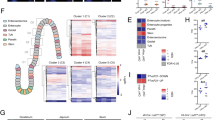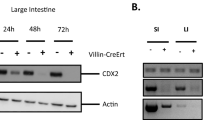Abstract
The microbial pattern-recognizing Toll-like receptors (TLRs) are major signal transducers known to shape and influence the postnatal maturation of host intestinal epithelium. Perturbations in this intricate host–microbe cross-talk have been reported to be associated with uncontrolled epithelial cell growth and thus potential cancer development by mechanisms which are largely unknown. We therefore generated transgenic mice carrying a constitutively active TLR4 (CD4-TLR4) linked to an intestinal epithelial cell-specific promoter. Ex vivo analysis of transgenic crypt-villus organoid cultures revealed an increased proliferative capacity and a lowered cyclooxygenase 2 (Cox-2) expression in these organoids compared with wild-type control cultures. Introducing the CD4-TLR4 transgene into APCMin/+ mice (CD4-TLR4-APCMin/+), a model of colorectal carcinoma, resulted in a dramatic drop in tumor load as compared with control APCMin/+ mice. Intestinal tumors from CD4-TLR4-APCMin/+ mice displayed reduced Cox-2 protein, elevated interferon β expression and increased caspase-3 activity, which correlated with increased apoptosis in vivo. Thus, our data reveal that host microbiota-mediated signal transduction via TLR4 in intestinal epithelial cells is far more complex than what is previously reported.
This is a preview of subscription content, access via your institution
Access options
Subscribe to this journal
Receive 50 print issues and online access
$259.00 per year
only $5.18 per issue
Buy this article
- Purchase on Springer Link
- Instant access to full article PDF
Prices may be subject to local taxes which are calculated during checkout





Similar content being viewed by others
References
Rakoff-Nahoum S, Medzhitov R . Regulation of spontaneous intestinal tumorigenesis through the adaptor protein MyD88. Science 2007; 317: 124–127.
Luo J-L, Maeda S, Hsu L-C, Yagita H, Karin M . Inhibition of NF-κ B in cancer cells converts inflammation- induced tumor growth mediated by TNFα to TRAIL-mediated tumor regression. Cancer Cell 2004; 6: 297–305.
Pidgeon GP, Harmey JH, Kay E, Costa MD, Redmond HP, Bouchier-Hayes DJ . The role of endotoxin/lipopolysaccharide in surgically induced tumour growth in a murine model of metastatic disease. Br J Cancer 1999; 81: 1311–1317.
Harmey JH, Bucana CD, Lu W, Byrne AM, McDonnell S, Lynch C et al. Lipopolysaccharide-induced metastatic growth is associated with increased angiogenesis, vascular permeability and tumor cell invasion. Int J Cancer 2002; 101: 415–422.
Chicoine M, Zahner M, Won E, Kalra R, Kitamura T, Perry A et al. The in vivo antitumoral effects of lipopolysaccharide against glioblastoma multiforme are mediated in part by Toll-like receptor 4. Neurosurgery 2007; 60: 372–380.
Andreani V, Gatti G, Simonella L, Rivero V, Maccioni M . Activation of Toll-like Receptor 4 on Tumor Cells In vitro Inhibits Subsequent Tumor Growth In vivo. Cancer Res 2007; 67: 10519–10527.
Maehara Y, Okuyama T, Kakeji Y, Baba H, Furusawa M, Sugimachi K . Postoperative immunochemotherapy including streptococcal lysate OK-432 is effective for patients with gastric cancer and serosal invasion. Am J Surg 1994; 168: 36–40.
Sato M, Harada K, Yoshida H, Yura Y, Azuma M, Iga H et al. Therapy for oral squamous cell carcinoma by tegafur and streptococcal agent OK-432 in combination with radiotherapy: association of the therapeutic effect with differentiation and apoptosis in the cancer cells. Apoptosis 1997; 2: 227–238.
Otto F, Schmid P, Mackensen A, Wehr U, Seiz A, Braun M et al. Phase II trial of intravenous endotoxin in patients with colorectal and non-small cell lung cancer. Eur J Cancer 1996; 32A: 1712–1718.
Razack AHA . Bacillus Calmette–Guérin and bladder cancer. Asian J Surg 2007; 30: 302–309.
Garay RP, Viens P, Bauer J, Normier Gr, Bardou M, Jeannin J-Fo et al. Cancer relapse under chemotherapy: Why TLR2/4 receptor agonists can help. Eur J Pharmacol 2007; 563: 1–17.
Smith WL, DeWitt DL, Garavito RM . CYCLOOXYGENASES: structural, cellular, and molecular biology. Annu Rev Biochem 2000; 69: 145–182.
Trifan OC, Hla T . Cyclooxygenase-2 modulates cellular growth and promotes tumorigenesis. J Cell Mol Med 2003; 7: 207–222.
Wang D, DuBois RN . Prostaglandins and cancer. Gut 2006; 55: 115–122.
Steinbach G, Lynch PM, Phillips RKS, Wallace MH, Hawk E, Gordon GB et al. The effect of celecoxib, a cyclooxygenase-2 inhibitor, in familial adenomatous polyposis. N Engl J Med 2000; 342: 1946–1952.
Swamy MV, Patlolla JMR, Steele VE, Kopelovich L, Reddy BS, Rao CV . Chemoprevention of familial adenomatous polyposis by low doses of atorvastatin and celecoxib given individually and in combination to APCMin mice. Cancer Res 2006; 66: 7370–7377.
Li Y, Kundu P, Seow SW, Teixeira de Matos C, Linda A, Chin KC et al. Gut microbiota accelerate tumor growth via c-Jun and STAT3 phosphorylation in APCMin/+ mice. Carcinogenesis 2012; 33: 1231–1238.
Yokota S-i, Okabayashi T, Rehli M, Fujii N, Amano K-i . Helicobacter pylori lipopolysaccharides upregulate toll-like receptor 4 expression and proliferation of gastric epithelial cells via the MEK1/2-ERK1/2 mitogen-activated protein kinase pathway. Infect Immun 2010; 78: 468–476.
Bohnhorst J, Rasmussen T, Moen SH, Flottum M, Knudsen L, Borset M et al. Toll-like receptors mediate proliferation and survival of multiple myeloma cells. Leukemia 2006; 20: 1138–1144.
Moser A, Pitot H, Dove W . A dominant mutation that predisposes to multiple intestinal neoplasia in the mouse. Science 1990; 247: 322–324.
Medzhitov R, Preston-Hurlburt P, Janeway CA . A human homologue of the Drosophila Toll protein signals activation of adaptive immunity. Nature 1997; 388: 394–397.
Sato T, van Es JH, Snippert HJ, Stange DE, Vries RG, van den Born M et al. Paneth cells constitute the niche for Lgr5 stem cells in intestinal crypts. Nature 2011; 469: 415–418.
Gregorieff A, Pinto D, Begthel H, Destrée O, Kielman M, Clevers H . Expression pattern of wnt signaling components in the adult intestine. Gastroenterology 2005; 129: 626–638.
Kargman SL, O’Neill GP, Vickers PJ, Evans JF, Mancini JA, Jothy S . Expression of prostaglandin G/H synthase-1 and -2 protein in human colon cancer. Cancer Res 1995; 55: 2556–2559.
Kutchera W, Jones DA, Matsunami N, Groden J, McIntyre TM, Zimmerman GA et al. Prostaglandin H synthase 2 is expressed abnormally in human colon cancer: evidence for a transcriptional effect. Proc Natl Acad Sci 1996; 93: 4816–4820.
Sheng H, Shao J, Kirkland SC, Isakson P, Coffey RJ, Morrow J et al. Inhibition of human colon cancer cell growth by selective inhibition of cyclooxygenase-2. J Clin Invest 1997; 99: 2254–2259.
Núňez NG, Andreani V, Crespo MI, Nocera DA, Breser ML, Morón G et al. IFNβ produced by TLR4-activated tumor cells is involved in improving the antitumoral immune response. Cancer Res 2012; 72: 592–603.
Cursio R, Colosetti P, Auberger P, Gugenheim J . Liver apoptosis following normothermic ischemia-reperfusion: in vivo evaluation of caspase activity by FLIVO assay in rats. Transplant Proc 2008; 40: 2038–2041.
Fukata M, Shang L, Santaolalla R, Sotolongo J, Pastorini C, España C et al. Constitutive activation of epithelial TLR4 augments inflammatory responses to mucosal injury and drives colitis-associated tumorigenesis. Inflamm Bowel Dis 2011; 17: 1464–1473.
Cohn SM, Simon TC, Roth KA, Birkenmeier EH, Gordon JI . Use of transgenic mice to map cis-acting elements in the intestinal fatty acid binding protein gene (FABPI) that control its cell lineage-specific and regional patterns of expression along the duodenal-colonic and crypt-villus axes of the gut epithelium. J Cell Biol 1992; 119: 27–44.
Sweetser D, Hauft S, Hoppe P, Birkenmeier E, Gordon J . Transgenic mice containing intestinal fatty acid-binding protein-human growth hormone fusion genes exhibit correct regional and cell-specific expression of the reporter gene in their small intestine. Proc Natl Acad Sci USA 1988; 85: 9611–9615.
Matsushita K, Takeuchi O, Standley DM, Kumagai Y, Kawagoe T, Miyake T et al. Zc3h12a is an RNase essential for controlling immune responses by regulating mRNA decay. Nature 2009; 458: 1185–1190.
Fukata M, Chen A, Klepper A, Krishnareddy S, Vamadevan AS, Thomas LS et al. Cox-2 is regulated by toll-like receptor-4 (TLR4) signaling: role in proliferation and apoptosis in the intestine. Gastroenterology 2006; 131: 862–877.
Brown SL, Riehl TE, Walker MR, Geske MJ, Doherty JM, Stenson WF et al. Myd88-dependent positioning of Ptgs2-expressing stromal cells maintains colonic epithelial proliferation during injury. J Clin Invest 2007; 117: 258–269.
Singh B, Berry JA, Shoher A, Ramakrishnan V, Lucci A . COX-2 overexpression increases motility and invasion of breast cancer cells. Int J Oncol 2005; 26: 1393–1399.
Müller-Decker K, Neufang G, Berger I, Neumann M, Marks F, Fürstenberger G . Transgenic cyclooxygenase-2 overexpression sensitizes mouse skin for carcinogenesis. Proc Natl Acad Sci 2002; 99: 12483–12488.
Nakamoto N, Higuchi H, Kanamori H, Kurita S, Tada S, Takaishi H et al. Cyclooxygenase-2 inhibitor and interferon-β synergistically induce apoptosis in human hepatoma cells in vitro and in vivo. Int J Oncol 2006; 29: 625–635.
Klampfer L, Huang J, Kaler P, Sasazuki T, Shirasawa S, Augenlicht L . STAT1-independent inhibition of cyclooxygenase-2 expression by IFNγ; a common pathway of IFNγ-mediated gene repression but not gene activation. Oncogene 2007; 26: 2071–2081.
Ohtsuka Y, Lee J, Stamm DS, Sanderson IR . MIP-2 secreted by epithelial cells increases neutrophil and lymphocyte recruitment in the mouse intestine. Gut 2001; 49: 526–533.
Arulampalam V, Grant PA, Samuelsson A, Lendahl U, Pettersson S . Lipopolysaccharide-dependent transactivation of the temporally regulated immunoglobulin heavy chain 3’ enhancer. Eur J Immunol 1994; 24: 1671–1677.
Sato T, Vries RG, Snippert HJ, van de Wetering M, Barker N, Stange DE et al. Single Lgr5 stem cells build crypt–villus structures in vitro without a mesenchymal niche. Nature 2009; 459: 262–265.
Acknowledgements
Our research work was funded by a grant from Singapore Immunology Network (SIgN)—SIgN 10-038. We would like to thank Dr Robert Wallin for his great expertise and assistance in using the deconvolution microscope for anti-CD4 fluorescence imaging. We thank Velmurugesan Arulampalam for valuable discussions regarding our study. We also thank Arlaine Anne Bautista Amoyo, Jieshun Wong and Annika Samuelsson for their technical support with animal care and handling.
Author information
Authors and Affiliations
Corresponding author
Ethics declarations
Competing interests
The authors declare no conflict of interest.
Additional information
Supplementary Information accompanies the paper on the Oncogene website
Supplementary information
Rights and permissions
About this article
Cite this article
Li, Y., Teo, W., Low, M. et al. Constitutive TLR4 signalling in intestinal epithelium reduces tumor load by increasing apoptosis in APCMin/+ mice. Oncogene 33, 369–377 (2014). https://doi.org/10.1038/onc.2012.581
Received:
Revised:
Accepted:
Published:
Issue Date:
DOI: https://doi.org/10.1038/onc.2012.581
Keywords
This article is cited by
-
Context-dependent functions of pattern recognition receptors in cancer
Nature Reviews Cancer (2022)
-
TLR4 signaling in the development of colitis-associated cancer and its possible interplay with microRNA-155
Cell Communication and Signaling (2021)
-
Organoid models of gastrointestinal cancers in basic and translational research
Nature Reviews Gastroenterology & Hepatology (2020)
-
Gut microbiota-mediated inflammation in obesity: a link with gastrointestinal cancer
Nature Reviews Gastroenterology & Hepatology (2018)
-
Myeloid translocation genes differentially regulate colorectal cancer programs
Oncogene (2016)



